U.S. Department of Transportation
Federal Highway Administration
1200 New Jersey Avenue, SE
Washington, DC 20590
202-366-4000
Federal Highway Administration Research and Technology
Coordinating, Developing, and Delivering Highway Transportation Innovations
|
R&T NOW This newsletter is an archived publication and may contain dated technical, contact, and link information. |
|
| Publication Number: Date: July/August 2019 |
Publication Date: July/August 2019
|
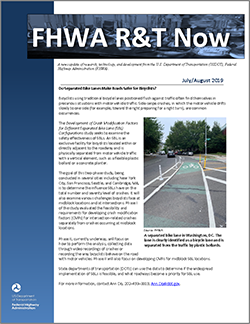
PDF files can be viewed with the Acrobat® Reader®
In this issue…
Bicyclists using traditional bicycle lanes positioned flush against traffic often find themselves in precarious situations with motor vehicle traffic. Side-swipe crashes, in which the motor vehicle drifts slowly to one side (for example, toward the right preparing for a right turn), are common occurrences.
The Development of Crash Modification Factors for Different Separated Bike Lane (SBL) Configurations study seeks to examine the safety effectiveness of SBLs. An SBL is an exclusive facility for bicyclists located within or directly adjacent to the roadway and is physically separated from motor vehicle traffic with a vertical element, such as a flexible plastic bollard or a concrete planter.
The goal of this two-phase study, being conducted in several cities including New York City, San Francisco, Seattle, and Cambridge, MA, is to determine the influence SBLs have on the total number and severity level of crashes. It will also examine various challenges bicyclists face at midblock locations and at intersections. Phase I of the study evaluated the feasibility and requirements for developing crash modification factors (CMFs) for intersection-related crashes separately from crashes occurring at midblock locations.
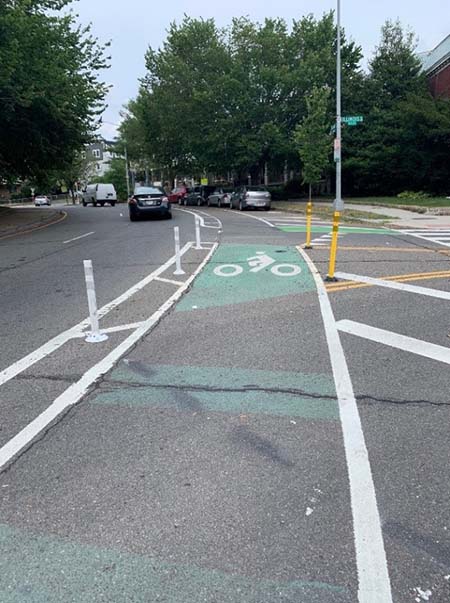
Source: FHWA
A separated bike lane in Washington, DC. The lane is clearly identified as a bicycle lane and is separated from the traffic by plastic bollards.
Phase II, currently underway, will focus on how to perform the analysis, collecting data through video recordings of crashes or recording the way bicyclists behave on the road with motor vehicles. Phase II will also focus on developing CMFs for midblock SBL locations.
State departments of transportation (DOTs) can use the data to determine if the widespread implementation of SBLs is feasible, and what roadways become a priority for SBL use.
For more information, contact Ann Do, 202–493–3319, Ann.Do@dot.gov.
The 2nd International Interactive Symposium on UHPC from June 2 through June 5 in Albany, NY, hosted more than 80 technical paper presentations and 5 interactive expert panel sessions on the state of the art and knowledge of UHPC.
The symposium attracted at least 300 attendees from 33 States and 21 foreign countries, and Benjamin Graybeal, FHWA's Team Leader for Bridge Engineering Research, co-chaired the symposium. Much of the technical content of the symposium focused on bridge construction, bridge rehabilitation, and other infrastructure-based uses of this new class of concrete because bridges are one of the largest applications of the technology in North America.
As a partner of the symposium, the New York State Department of Transportation (NYSDOT) organized symposium attendee visits to two live UHPC bridge construction sites and a set of already-constructed bridges. Other symposium attendees visited a precast concrete plant where they witnessed the mixing and placement of four different UHPC products.
Because NYSDOT used UHPC in the construction of 70 bridges over the past decade, their agency was able to share best practices with attendees.
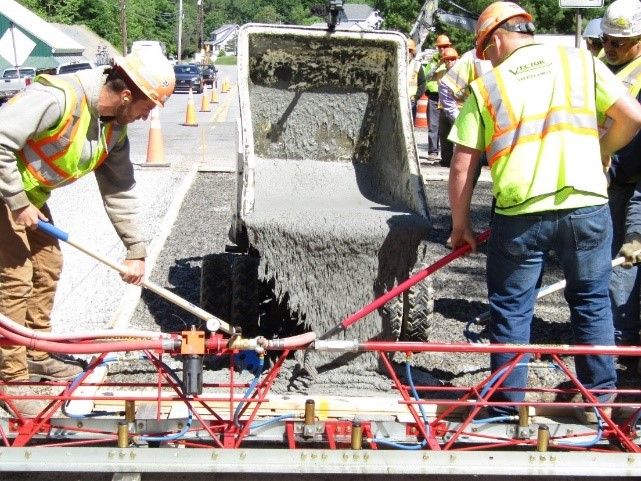
Source: FHWA
Highway workers install a UHPC overlay on a deteriorated bridge deck.
Symposium attendees gained hands-on experience with the means and methods of infrastructure construction with UHPC.
When combined with the formal technical content offered elsewhere in the symposium program, this event helped to demystify the use of this promising class of concrete.
For more information, contact Benjamin Graybeal, 202–493–3122, Benjamin.Graybeal@dot.gov.
Recently, the U.S. Senate and U.S. House of Representatives Committees on Appropriations requested that FHWA assess the impact and value of certification requirements for workers performing bridge corrosion prevention work.
In response to the request of the U.S. Congress, FHWA submitted the results of a research study on corrosion prevention worker certifications. The Report on Industry-Recognized Corrosion Prevention Worker Certifications Effectiveness Evaluation was prepared by FHWA's Office of Infrastructure Research and Development (R&D) and submitted on June 5, 2019.
The report documents the research conducted on worker certifications for blasting and painting bridges, and the information analyzed from specific bridge corrosion prevention projects. The report mostly focuses on contractor certification because that type of program has been implemented for many years. Worker certification—certification focused on the individual worker and not the contracting company—is newer and in the process of being implemented within the bridge painting industry.
Findings suggest that little to no data were tracked or recorded that connected overall project quality to worker certifications. Consensus from various State DOT bridge owners, however, found that contractor certifications have been very successful in allowing owners to make informed choices for contractors, and that the program has improved overall quality. The expectation is that worker certifications will also be beneficial to contractors on an individual basis, just as certifications have been beneficial to contractors.
For more information, contact Donald Becker, 202–493–3532, Donald.Becker@dot.gov.
Researchers at FHWA's Turner-Fairbank Highway Research Center (TFHRC) Office of Infrastructure R&D recently published Formation Factor Demystified and Its Relationship to Durability. Developed to help practitioners understand the utility of concrete electrical resistivity, this techbrief covers how to measure formation factor, its limitations, and its relationship with durability.
The techbrief also explores the formation factor as it relates to the concrete pore volume and pore connectivity. This document aims to demystify the formation factor by discussing how it is obtained, the options to determine the pore solution resistivity, and the "bucket test," an alternative to simplify this process.
Formation factor will ultimately give an indication of how permeable the concrete is and how it will be affected by salt and moisture intrusion. In the long run, the formation factor will provide users with a measure of concrete durability and longevity.
For more information, contact Ahmad Ardani, 202–493–3422, Ahmad.Ardani@dot.gov. The document is available to download via https://www.fhwa.dot.gov/publications/research/infrastructure/pavements/19030/index.cfm.
As part of the rollout of the latest version of the CARMA PlatformSM, FHWA purchased four automated passenger vehicles that joined the CARMASM fleet in June 2019.
The CARMA Platform is an open-source software (OSS) platform introduced by FHWA that enables the testing and evaluation of cooperative automation concepts for improving safety and increasing infrastructure efficiency. The CARMA Platform facilitates the research and development of cooperative interactions by infrastructure owner–operators and the automotive industry. FHWA developed the innovative CARMA Platform to encourage collaboration with the goal of improving transportation efficiency and safety.
The new fleet vehicles include a minivan, a midsized sedan, and two Sport Utility Vehicles (SUVs). The vehicles will be used for safety and operations research, and one of the SUVs is equipped with an eye-tracking system for human-factors research. All four vehicles were equipped in Illinois by AutonomouStuff (a company that provides research and development platforms, products, software, engineering services, and data intelligence to aid in the advancement of robotics and autonomy) and are capable of Society of Automotive Engineers (SAE) level-2 automation.
The newest beta version of the CARMA PlatformSM, called CARMA3, was released on GitHub in July and is being migrated onto the new vehicles for implementation and testing.
The primary features of CARMA3 include:
CARMA enables Automated Driving Systems to navigate more safely and efficiently with other vehicles and roadway infrastructure though communication and cooperation, and as development of CARMA3 continues, community members are encouraged to download and make contributions to the OSS via GitHub.
For more information, contact Taylor Lochrane, 202–493–3293, Taylor.Lochrane@dot.gov, or visit https://highways.dot.gov/research/research-programs/operations/CARMA.
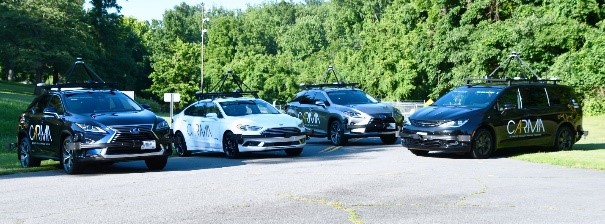
Source: FHWA
The CARMASM fleet.
The Federal Highway Administration (FHWA) and Intelligent Transportation Systems Joint Program Office (ITSJPO) maintain the Connected and Automated Vehicle (CAV) Support Services program, which provides equipment loans and no-cost technical support to infrastructure owner-operators (IOO) and other organizations interested in testing CAV technology.
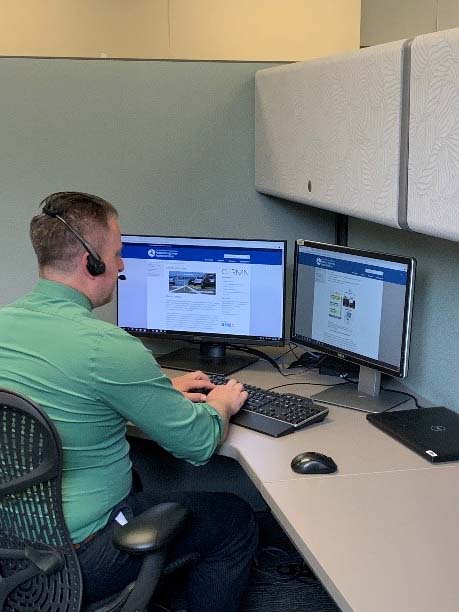
Source: FHWA
An analyst provides technical support for testers of connected and automated vehicles.
CAV Support Services' equipment loan program provides users the opportunity to become familiar with the types of equipment typically used in connected vehicle (CV) deployment. Available equipment includes:
CAV Support Services also offers a Help Desk that provides users with technical assistance during CAV testing and deployments.
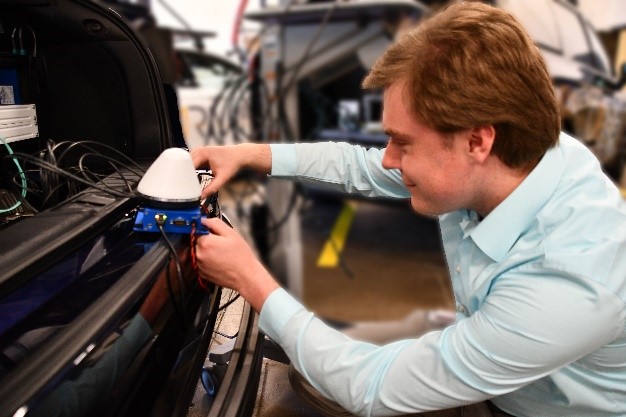
Source: FHWA
A researcher equips a connected vehicle with an OBU.
Some of the services include:
Users can submit a support ticket from ITSJPO's Resources for Practitioners page. IOOs that participate can make technology adoption more efficient by troubleshooting with expert technical support. CAV Support Services also provides the opportunity to test equipment from a variety of vendors in a no-cost environment. For more information, contact CAVSupportServices@dot.gov.
FHWA staff attended the 2019 American Association of State Highway and Transportation Officials (AASHTO) National Research Advisory Committee (RAC) and TRB State Representatives Meeting in Santa Fe, NM, July 22–25, 2019.
Sessions at the meeting included a question-and-answer panel featuring Shana Baker, Director, Office of Corporate Research, Technology, and Innovation Management in FHWA's Office of Research, Development, and Technology (RD&T). The session, "View from the TOP—Interactive Ideas Discussion," examined several topics, including connected and automated vehicles and future visions for the Nation's highway research programs. Jack Jernigan and David Pamplin of the FHWA Office of RD&T presented New FHWA Guidance for SP&R [State Planning and Research] Program, which highlighted changes to the new guidance for the SP&R Program. The purpose of the revised guidance is to assist State DOTs and FHWA staff in implementing the regulations contained in 23 CFR Part 420, Subpart B RD&T Transfer Program Management.
Additional FHWA staff presented posters related to ongoing research and technology transfer activities being led by FHWA.
Each AASHTO State Member is represented on the RAC. RAC State members receive SP&R funds to conduct research to meet individual State needs. The RAC is a critical partner in carrying out FHWA's Research, Technology, and Education programs.
For more information, contact Jack Jernigan, 202–493–3363, Jack.Jernigan@dot.gov.
Articles include: Taking Inspection to New Heights; Data-Driven Safety Analysis; Crowdsourcing for Operations; Innovation Through Collaboration and Communication; Accelerating Market Readiness; States Innovate!; Every Day Counts Success Stories
The issue is available online.
This issue includes: A New Home for Bridge Data; Transforming Transportation in Tampa; Partnering in a Crisis; From Farm to Table; A Pathway to Secure Connections
The issue is available online.
For more information, contact Lisa Shuler, Lisa.A.Shuler@dot.gov.
Please forward this newsletter to others you think might find it interesting and/or useful.
Suggestions may be submitted to FHWA_Now@fhwa.dot.gov.
FHWA R&T Now is a newsletter containing information and updates about research, technology, and development from the U.S. Department of Transportation, Federal Highway Administration. The newsletter is an electronic newsletter and is updated approximately every other month.
Send your comments, questions, and feedback to FHWA_Now@dot.gov.
Online access:
https://www.fhwa.dot.gov/publications/rtnow/.
Mail:
Federal Highway Administration
FHWA Office of Research, Development, and Technology
Attention: R&T Now Managing Editor
6300 Georgetown Pike
McLean, VA 22101
| AASHTO | American Association of State Highway and Transportation Officials |
|---|---|
| CAV | Connected and Automated Vehicle |
| CMF | Crash Modification Factor |
| CV | Connected Vehicle |
| DOT | Department of Transportation |
| FHWA | Federal Highway Administration |
| IOO | Infrastructure Owner-Operators |
| IPv6 | Internet Protocol Version 6 |
| ITSJPO | Intelligent Transportation Systems Joint Program Office |
| LTBP | Long-Term Bridge Performance |
| NYSDOT | New York State Department of Transportation |
| OBU | Onboard Unit |
| OSS | Open-source Software |
| R&D | Research and Development |
| RAC | Research Advisory Council |
| RD&T | Research, Development, and Technology |
| RSU | Roadside Units |
| SAE | Society for Automotive Engineers |
| SBL | Separated Bike Lane |
| SES | Senior Executive Service |
| SP&R | State Planning and Research |
| SPaT | Signal Phase and Timing |
| SUV | Sport Utility Vehicle |
| TFHRC | Turner-Fairbank Highway Research Center |
| TRB | Transportation Research Board |
| UHPC | Ultra-High Performance Concrete |
| USDOT | United States Department of Transportation |
Distribution–FHWA R&T Now is being distributed according to a standard distribution. Direct distribution is being made to the FHWA Divisions and Resource Center.
Key Words–LTBP, bridges, safety, infrastructure, operations, bicycles, bicyclists, separated bike lanes, connected and automated vehicles, intelligent transportation systems, concrete, ultra-high performance concrete, research.
Notice–This document is disseminated under the sponsorship of the U.S. Department of Transportation in the interest of information exchange. The U.S. Government assumes no liability for the use of the information contained in this document. The U.S. Government does not endorse products or manufacturers. Trademarks or manufacturers' names appear in this document only because they are considered essential to the objective of the document.